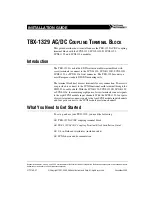
Glossary
3004149-0001 Revision B
63
IP Address
: An Internet Protocol address, or IP address, is a
number that uniquely identifies the computer accessible over a
TCP/IP-based LAN or the Internet that is sending or receiving
information. An IP address is a 32-bit numeric address written as
four numbers, separated by periods and each number is between
0 and 255. For example, 207.115.79.4 is an IP address. In the
BGAN system, IP addresses for the Network and the TE can be
dynamic or static.
Network Dynamic IP Address
: A network dynamic IP
address is a temporary address that is assigned by your BGAN
Service Provider when you connect to the BGAN Network.
Network Static IP Address
: If required, a static IP address
can be assigned by Service Providers to BGAN users when the
SIM is provisioned. This static IP address is used every time
you connect to the BGAN network and is associated with a
specific username and password.
DHCP Address
: Local IP address that is assigned by the UT
DHCP server to the TE once connected to the UT. This is a
private IP address that is not routable within the Internet.
Terminal Local IP Address
: IP address of the UT to access
the web UI and talk to the UT via LaunchPad. This address is
configurable by the user. The default local IP address of the
terminal is 192.168.128.100.
Standard Connection
: A standard connection is charged by
volume of data sent. The bandwidth you are allocated depends
on terminal type and network availability, but is always ‘best
effort’, that is, you are allocated bandwidth depending on your
requirements and the requirements of other users of the BGAN
network, or BGAN Terminal. This connection class is suitable
for most data types, other than multimedia.
Streaming
: A streaming connection gives you a guaranteed data
rate and is charged by the amount of time the connection is
active. Streams are typically used for multimedia data, such as
video.
TE (Terminal Equipment):
Terminal equipment refers to the
piece of equipment that is connected to the BGAN UT (e.g.
laptop, video equipment, phone, etc.)
Traffic Flow Template
: A Traffic Flow Template, also called
an Application Template, is a series of data filters such as QoS
(Quality of Service), PDP Context and security settings that
allow the Core Network to classify packets received from an
external network into the correct PDP Context. When incoming
data arrives at an access point in the core network, a packet
classifier will make a PDP Context selection based on the Traffic




































